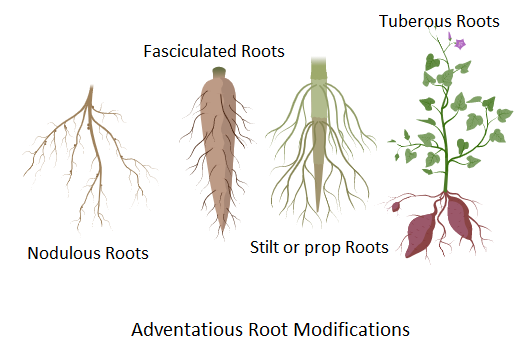
Answer
442.8k+ views
Hint: Screwpine also known as Pandanus and are monocots, dioecious plants that range widely from small shrubs to large trees. They are old trophic species of Tropic and Subtropic regions. Their roots are like anchors in the loose soil. As they form a huge canopy, the roots act to hold the trees upright in position.
Complete answer: Screwpine or Screwpalm belongs to a genus of monocots. The trees are dioecious meaning that male and female organs are on different trees. They form a huge dense canopy with leaves, heavy fruit, and sometimes branches. They vary in size from shrubs to tall trees. The tall trees are kept upright with the help of adventitious roots that act as anchors for the tree.
Let us understand the characteristic features of all the given types of roots to determine which of them is found in screwpine.
-Nodulose roots are a modification of adventitious roots that have developed bead-like structures on it. These beads are called nodules. The nodules usually enclose various symbiotic bacterial species that help in nitrogen fixation for the plant. It is a root modification that supports storage. They are found in plants like ginger, soybean, etc.

-Tuberous roots are irregularly shaped storing type roots that have a swollen body. These are seen in sweet potato.
-Stilt roots are also a modification of adventitious roots. These roots grow from the basal nodules of the stem. They are a type of supporting root system. They are strong and appear near but above the soil level. They act as anchors in the soil. These are seen in sugarcane, screwpine, etc.
-Fasciculated roots are tuberous type adventitious roots. They have a definite shape, unlike the irregular tuberous roots. They appear in clusters and serve the function of food storage. These are found in Dahlia.
Therefore, the right answer is option C, i.e., The screwpine exhibits the presence of stilt roots.
Note: The screw pines are generally confused with palm trees. But these are not closely related. The screw pines are considered economically, culturally, and medicinally beneficial. The stilt roots are thick and anchor-shaped that helps the tall trees to stay straight and provides strength to the plant body. Roots are modified based on the habitats in which the plant grows.
Complete answer: Screwpine or Screwpalm belongs to a genus of monocots. The trees are dioecious meaning that male and female organs are on different trees. They form a huge dense canopy with leaves, heavy fruit, and sometimes branches. They vary in size from shrubs to tall trees. The tall trees are kept upright with the help of adventitious roots that act as anchors for the tree.
Let us understand the characteristic features of all the given types of roots to determine which of them is found in screwpine.
-Nodulose roots are a modification of adventitious roots that have developed bead-like structures on it. These beads are called nodules. The nodules usually enclose various symbiotic bacterial species that help in nitrogen fixation for the plant. It is a root modification that supports storage. They are found in plants like ginger, soybean, etc.

-Tuberous roots are irregularly shaped storing type roots that have a swollen body. These are seen in sweet potato.
-Stilt roots are also a modification of adventitious roots. These roots grow from the basal nodules of the stem. They are a type of supporting root system. They are strong and appear near but above the soil level. They act as anchors in the soil. These are seen in sugarcane, screwpine, etc.
-Fasciculated roots are tuberous type adventitious roots. They have a definite shape, unlike the irregular tuberous roots. They appear in clusters and serve the function of food storage. These are found in Dahlia.
Therefore, the right answer is option C, i.e., The screwpine exhibits the presence of stilt roots.
Note: The screw pines are generally confused with palm trees. But these are not closely related. The screw pines are considered economically, culturally, and medicinally beneficial. The stilt roots are thick and anchor-shaped that helps the tall trees to stay straight and provides strength to the plant body. Roots are modified based on the habitats in which the plant grows.
Recently Updated Pages
Who among the following was the religious guru of class 7 social science CBSE

what is the correct chronological order of the following class 10 social science CBSE

Which of the following was not the actual cause for class 10 social science CBSE

Which of the following statements is not correct A class 10 social science CBSE

Which of the following leaders was not present in the class 10 social science CBSE

Garampani Sanctuary is located at A Diphu Assam B Gangtok class 10 social science CBSE

Trending doubts
A rainbow has circular shape because A The earth is class 11 physics CBSE

Which are the Top 10 Largest Countries of the World?

Fill the blanks with the suitable prepositions 1 The class 9 english CBSE

Which of the following was the capital of the Surasena class 6 social science CBSE

How do you graph the function fx 4x class 9 maths CBSE

The Equation xxx + 2 is Satisfied when x is Equal to Class 10 Maths

Give 10 examples for herbs , shrubs , climbers , creepers

Difference between Prokaryotic cell and Eukaryotic class 11 biology CBSE

Who was the first Director General of the Archaeological class 10 social science CBSE




